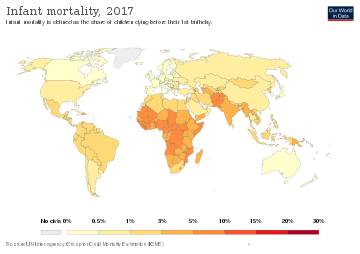婴儿死亡率
婴儿死亡率(英語:infant mortality rate,缩写为IMR)是指每1000名活产儿中在一岁前死亡的人口数[1][2][與來源不符]。这个比率是衡量一个国家健康水平的指标。由于婴儿死亡率只统计一岁以下的数据, 而统计五岁以下儿童死亡的儿童死亡率也是一个重要的统计数据[3]。

2013年時,美國婴儿死亡死因的第一名是先天缺陷[4]。其他的死因有出生窒息、肺炎、先天性障碍、足月分娩併發症(例如臍帶脫垂或是滯產[5]、新生兒感染、腹瀉、疟疾、麻疹及營養不良[6]。)婴儿死亡死因中,最常見可預防的原因是孕婦在懷孕時吸煙[7]。沒有產前檢查、孕婦在懷孕時飲酒或是管制藥物使用也可能會導致併發症,造成婴儿死亡[8][與來源不符]。許多環境因素會影響婴儿死亡率,例如母親的教育程度、環境因素、政治以及醫療上的基礎建設[9]。改善卫生设施、讓大家可以取得潔淨的飲用水、提昇對感染性疾病的免疫,以及其他公共卫生措施都有助於降低婴儿死亡率。
2018年的报告给出的世界平均婴儿死亡率为千分之30。[10] 而五岁以下儿童死亡率为千分之39。 跟1990年相比已有很好的改善。[11]
統計
编辑前十大高嬰兒死亡率的國家有:
嬰幼兒死亡率和平均壽命的關係
编辑古代嬰幼兒死亡率高,是古代平均壽命低的主要原因,像例如說在十三世紀時,英國貴族的平均壽命大約是30歲。但當時,對於活到21歲的成年男性而言,他們依舊能預期活到大約62至70歲左右。[12][13]嬰幼兒死亡率的巨幅下降,是20世紀中期以前平均壽命增長的最可能的原因(然而二十世紀中期後平均壽命增加的主要原因變為老年人壽命增加)。[14]因此有理由認為所謂的古代人「平均壽命都不超過50歲」,因為「很多人在30-40歲的青壯年期間因為戰亂或疾病而離世」之類的說法,是錯誤的;然而應當注意的是,有時也會出現人們平均壽命與實際死亡的壽命差不多的狀況,像例如曾有人對古羅馬遺址做研究,結果發現古羅馬勞工階級的死亡壽命大多在30歲左右。[13]
參考文獻
编辑- ^ Mathews TJ, MacDorman MF. Infant mortality statistics from the 2009 period linked birth/infant death data set (PDF). National Vital Statistics Reports. January 2013, 61 (8): 1–27 [2020-08-25]. PMID 24979974. (原始内容存档 (PDF)于2020-11-15).
- ^ Indicator Metadata Registry Details. www.who.int. [2020-07-29]. (原始内容存档于2021-01-15) (英语).
- ^ Under-Five Mortality. UNICEF. [2017-03-07]. (原始内容存档于2020-04-23).
- ^ Mathews TJ, MacDorman MF, Menacker F. Infant mortality statistics from the 1999 period linked birth/infant death data set (PDF). National Vital Statistics Reports. January 2002, 50 (4): 1–28 [2020-08-25]. PMID 11837053. doi:10.1037/e558952006-001. hdl:1903/24216. (原始内容存档 (PDF)于2021-03-09).
- ^ Labor and Delivery Complications -- the Basics. WebMD. [2017-03-16]. (原始内容存档于2019-01-30).
- ^ Infant Mortality & Newborn Health. Women and Children First. [2017-04-25]. (原始内容存档于2019-12-10).
- ^ Hall ES, Venkatesh M, Greenberg JM. A population study of first and subsequent pregnancy smoking behaviors in Ohio. Journal of Perinatology. November 2016, 36 (11): 948–953. PMID 27467563. S2CID 29303225. doi:10.1038/jp.2016.119.
- ^ CDC. Commit to Healthy Choices to Help Prevent Birth Defects | CDC. Centers for Disease Control and Prevention. 2020-06-03 [2020-07-30]. (原始内容存档于2021-03-04) (美国英语).
- ^ Genowska A, Jamiołkowski J, Szafraniec K, Stepaniak U, Szpak A, Pająk A. Environmental and socio-economic determinants of infant mortality in Poland: an ecological study. Environmental Health. July 2015, 14: 61. PMC 4508882 . PMID 26195213. doi:10.1186/s12940-015-0048-1.
- ^ UN Inter-agency Group for Child Mortality Estimation. CHILD SURVIVAL: KEY FACTS AND FIGURES (PDF). Levels & Trends in Child Mortality. 2018, (Report 2018): 2 [2019-09-13]. (原始内容 (PDF)存档于2020-02-08).
- ^ Levels and Trends in Child Mortality Report 2018 | United Nations Population Division | Department of Economic and Social Affairs. www.un.org. [2019-09-13]. (原始内容存档于2021-03-08) (英语).
- ^ Lancaster, H. O. Expectations of life : a study in the demography, statistics, and history of world mortality. New York: Springer-Verlag. 1990: 8. ISBN 9781461210030.
- ^ 13.0 13.1 Amanda Ruggeri. Do we really live longer than our ancestors?. BBC. BBC. 2018-10-03 [2023-01-10]. (原始内容存档于2023-03-21).
- ^ How has life expectancy changed over time?. Office for National Statistics. [2023-01-10]. (原始内容存档于2023-03-28).